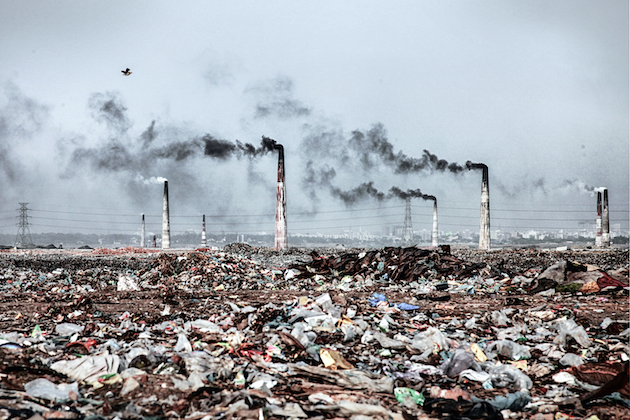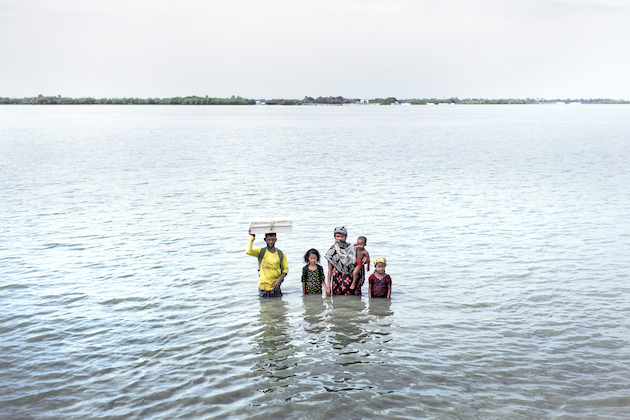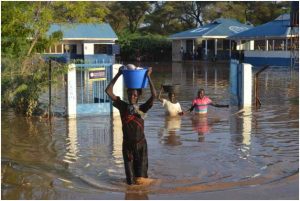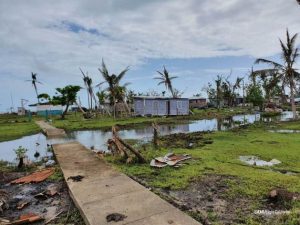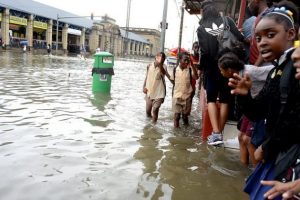
Flooding in Trinidad’s capital of Port of Spain. Climate justice calls for a fair and equitable response to climate change, recognizing the interconnectedness of our world and the shared responsibility we have in protecting it. Credit: Peter Richards/IPS
By Kibo Ngowi
JOHANNESBURG, Sep 1 2023 – If you’ve never seen a landslide before, it’s a terrifying force of nature. Those who have found themselves in the thick of this phenomenon say the earth beneath your feet suddenly begins to give way, the ground cracks open, and large masses of soil, rocks, and debris come crashing down. It is as if the very ground you stand on is rebelling against the changing climate and its impact on the delicate balance of the environment.
Hari Maya Parajuli, a farmer in Nepal, was unfortunate enough to have a farm in the destructive path of just such a landslide. All her crops and tomato tunnels were destroyed in an instant – a devastating loss for her household. Extreme weather events of this kind are becoming increasingly common. Over the past three decades, the frequency and intensity of hurricanes, floods, droughts, landslides and heatwaves, have increased by 45%, posing severe threats to vulnerable communities and ecosystems worldwide.
Climate justice recognizes that the impacts of climate change are not distributed equally and that the groups that are the most severely affected by the consequences of climate change contribute the least to the underlying causes of the problem
At 43 years of age, Hari lives with her husband’s parents in the Nepali village of Ghatichhina. Her husband and three children left years ago to find work abroad and her parents-in-law are elderly, leaving her with no choice but to take on the labor of maintaining their farm by herself. After the devastating landslide, Hari began going to the Village Development Committee and the local office of the Agricultural Department continuously seeking some form of assistance. But it was in vain.
Hari continues to grow vegetables such as cauliflower, rice and maize and tends to her livestock consisting of one buffalo, one calf and four goats but adverse weather conditions persist in sabotaging her efforts. “It is especially risky during the Monsoon season,” she explains. “Our farm is at the river basin so we are exposed to floods from above and below. The rain has become so erratic that we experience periods of heavy rainfall which cause flooding and other periods of drought which make the land dry and difficult to farm.”
Around 65% of Nepal’s population relies on agriculture as their primary source of income but these extreme weather events contribute to 90% of the country’s crop loss. The UN estimates that climate change could push an additional 130 million people into extreme poverty by 2030 and the Global Commission on the Economy and Climate predicts that failure to address climate change could cost the global economy $23 trillion by 2050.
“It has been around 17 years since my husband went abroad,” Hari says. “He couldn’t find employment in Nepal and we needed money to educate our children and maintain our household. This year I have somehow managed but I don’t think I can continue farming next year. I am not healthy and neither are others in the family. If and when my husband returns, I am planning to open a homestay.”
Hari’s story is just one example of how climate change disproportionately affects the most vulnerable communities, including low-income populations, indigenous peoples, communities of color, and women and children, who contribute the least to greenhouse gas emissions but bear the brunt of its consequences.
This is why we need climate justice – the fair and equitable treatment of all individuals and communities, particularly the most vulnerable and marginalized, in the context of addressing and responding to climate change. Climate justice recognizes that the impacts of climate change are not distributed equally and that the groups that are the most severely affected by the consequences of climate change contribute the least to the underlying causes of the problem.
The Climate Inclusion Fellowship
Starting in 2022, Accountability Lab (AL) Nepal hosted a Climate Inclusion Fellowship in which they recruited 12 young Nepali women interested in climate justice to reach out to different communities affected by climate change and to amplify the concerns and personal experiences of these communities through creative storytelling methods and mediums.
“Our goal was to build a network of young people who would not only identify the most pressing impacts of climate change, but would also be there to collaboratively uncover solutions to these problems with the people most affected,” explains Prekkshya Bimali, a Program Officer at AL Nepal who managed the fellowship. “We also wanted to take it a step further and connect these communities with the local authorities who have the power to implement these solutions at scale.”
The Climate Inclusion Fellows produced a short film around Hari Maya Parajuli’s experiences to highlight how climate change is deepening gender inequality in rural Nepal. Thousands of Nepali citizens, mostly men, have been forced to migrate in search of better work opportunities largely because climate change has had a devastating effect on male-dominated sectors such as agriculture. This has left scores of women overburdened with the task of maintaining households and raising children while also trying to earn an income.
Another important story the fellows uncovered was that of the Jalari community, an indigenous community in the city of Pokhara whose livelihood is dependent on fishing and has been heavily impacted by climate change. The water level in the lakes of Pokhara Valley has been decreasing for years, which has reduced the number of fish in the lake and forced the Jalari to introduce exotic species to counter the extinction of local species. Additionally, floods and landslides have led to the sedimentation of the lake, which further reduces the water level and pollutes the water itself.
“We don’t talk often enough about the differential impacts brought about by climate change to women, indigenous communities and other minorities,” says Climate Inclusion Fellow Urusha Lamsal. “So it was essential to reach out to these communities to understand the consequences of climate change from their perspective and how they are directly affected.”
Prekkshya explains that the goal of producing the short films on these issues was to amplify the voices of the affected communities and to also create dialogue between these communities and local authorities. “We have started doing public screenings where we also create space for local officials to engage with community members on these issues,” she says. “We have already screened the films in the very places where these issues are being experienced and we’re trying to reach out to as many as many people as we can.”
“These films will serve as an important advocacy tool as we continue to engage with the government on how these issues can be addressed in a way that is conscious of the needs and input of communities such as the Jalari. We are hopeful that these discussions will lead to meaningful change in the lives of the people most affected by climate change.”
Green Accountability
“It’s essential that we elevate communities on the frontlines of the climate crisis, especially indigenous communities, in shaping climate finance and solutions, because we won’t be successful without them,” says Grace Sinaga, Communications and Knowledge Management team lead at the World Bank’s Global Partnership for Social Accountability (GPSA). “This is something we at the GPSA like to call green accountability.” Accountability Lab is partnering with the GPSA on a new initiative to drive green accountability globally.
Grace goes on to highlight how in Australia, whenever bushfires occur, disaster management experts have found that community led action is more sustainable and effective in the long run. The indigenous people honor their land and understand that the eucalyptus trees need fire in order to reproduce.
Australia’s indigenous peoples have been managing and controlling bushfires in ways that are effective and safe for both their communities and forests such as through cultural burning techniques for centuries. Today, the value of traditional ecological knowledge through indigenous land management experts is recognized by the Australian government and even included in school curricula.
“Unfortunately, indigenous knowledge receives only 1% of climate finance globally, despite safeguarding 80% of the world’s remaining biodiversity, and less than 10% of climate funding has been prioritized for local activities,” explains Grace.
“We need to support indigenous peoples and local communities by creating systemic ways for people to have a voice and role in the climate decisions that most impact their lives. Green accountability places citizens and civil society at the heart of climate finance to direct funding, implement solutions and hold decision makers accountable for effective and equitable climate, finance and action.”
Ben Bakalovic, an Operations and Strategy Analyst at the GPSA, warns that we have to be careful because climate finance is a rapidly growing field that everybody wants a stake in, even if they’re not genuinely contributing to the solutions. “For instance, you see a lot of cases of international corporations taking land away from indigenous communities and rich countries claiming they are giving out climate finance when in reality, they’re financing chocolate and ice cream stores across Asia,” he explains.
This is why it’s crucial to have transparency measures that clearly map out what climate finance is, where it is going, who is implementing it, and what kind of impact it is meant to create. These measures would enable the most severely affected communities to better be able to track where climate finance is actually flowing.
“These people must logically be the ones that will be developing and implementing the solutions because local communities have a lot of knowledge that can be used for more effective climate action, both in mitigation and also in adaptation,” says Bakalovic.
“And then lastly, on accountability, it’s just about having governance measures in place that are used for avoiding corruption, have real oversight allowed for monitoring, tracking for effectiveness measurements. And this also really depends on the state and on the global and national levels.”
Justice for all
Climate justice is not just an abstract concept; it is a pressing need for humanity’s survival and well-being. The stories of individuals like Hari Maya Parajuli and communities like the Jalari show us how climate change disproportionately affects the most vulnerable among us. As extreme weather events become more frequent and intense, it is crucial to recognize that those who contribute the least to greenhouse gas emissions are often the ones who bear the heaviest burden.
Efforts like the Climate Inclusion Fellowship and green accountability initiative are steps in the right direction, empowering communities to be part of the solution and ensuring that climate finance reaches those who need it the most. We must continue to amplify the voices of the affected, engage with local authorities, and foster dialogue to bring about meaningful change.
Climate justice calls for a fair and equitable response to climate change, recognizing the interconnectedness of our world and the shared responsibility we have in protecting it. By prioritizing the needs and perspectives of the most vulnerable, we can build a more sustainable and resilient future for all. It is time for action, compassion, and solidarity in the pursuit of climate justice, so that no one is left behind in the face of this global challenge. Let us work together to safeguard our planet and ensure a just and livable world for generations to come.
Kibo Ngowi is Marketing & Communications Officer at Accountability Lab Global


